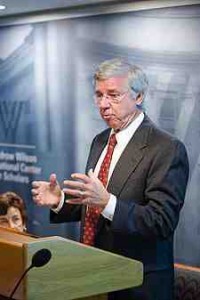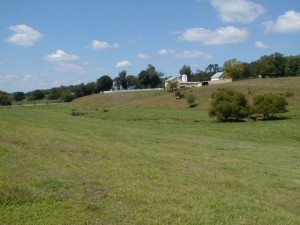
News
By Admin, May 19, 2011
Crossposted from Farmland Preservation Report.
Originally written by Bob Heuer
Buy-in from farmland owners on suburbia’s edge can accelerate efforts to create compact, walkable communities in metropolitan regions nationwide. So says Parris Glendening, president of Smart Growth America’s Leadership Institute. This Washington-based non-profit agency helps local governments implement strategies that target housing and transportation investment near jobs, shops and schools.

Stable urban-edge farm economies will encourage urban reinvestment by acting as a market-based firewall to impede suburbia’s outward march, according to Glendening—a national leader for smart growth during two terms as governor of Maryland, serving from 1995 to 2003.
The Glendening administration created a number of innovative incentives for local governments to encourage more compact patterns of development. Maryland’s Rural Legacy Program, one of Glendening’s most successful programs, has preserved large blocks of agricultural and natural land. Less successful was a law that targeted state assistance to “priority funding areas”—i.e. urbanizing locales that met smart growth criteria.
“I used to say the best tool against sprawl is a prosperous agricultural community,” Gov. Glendening recalls. “People who are opposed to sprawl often don’t understand the importance of farmers remaining economically viable. And the ag community was often hostile towards smart growth. They view their land as their own IRA and want to protect their right to the very logical alternative of selling for development.”
Maryland’s initiatives helped boost local farm economies by expanding both the supply and demand for farmers markets products. Yet, the focus on environmental outcomes like open space and habitat protection sparked a political impasse.
Gov. Glendening sees potential for a “a new kind of conversation” emanating from the nationwide movement to know the source of food. Unmet consumer demand for local food creates comparative advantages for farmers near population centers and, thus, a strong economic rationale for a comprehensive policy framework that promotes farmland preservation and agricultural development.
The Leadership Institute is affiliated with Smart Growth America—a national advocacy organization that supports farmland preservation as a means to encourage reinvestment in “existing” urban and suburban communities. Gov. Glendening says both organizations need to do a better job of recognizing exurban farming areas as another “existing” community in need of reinvestment: “We have some partners involved in agriculture and rural development but haven’t made this connection as explicit as we should.”

This myopia is reflected in the Obama Administration’s Sustainable Communities Initiative—a partnership between HUD, DOT and EPA. In FY 2011, Congress appropriated $70 million for HUD-administered regional planning grants to help guide state, metropolitan, and local investments in land use, transportation and housing.
The lion’s share of the funds goes to metropolitan planning organizations (MPOs). For decades, MPOs have treated urban-edge agriculture as a temporary land use pending inevitable suburbanization. Some MPOs—such as those in Philadelphia, Sacramento and Columbus—are beginning to explore ways to sustain their regional agriculture industries.
A more typical example is the Chicago Metropolitan Agency for Planning. CMAP recently received a $4 million HUD grant to support implementation of its 2040 Plan for northeastern Illinois. CMAP’s idea for “sustainable communities” acknowledges that maybe farmland isn’t empty space best paved over. Indeed, the plan recommendation to “promote sustainable local food” is a historic point of departure reflecting the recognition that agriculture as an enduring asset. Urban, suburban and exurban constituencies are beginning to target parcels of underutilized private and publicly owned land for local food production and related businesses.
But local food is a sliver of the region’s agricultural market segments. In CMAP’s seven-county planning jurisdiction, farming occupies a land mass about six times the size of the city of Chicago. The decisions of northeastern Illinois farmland owners and renters affect all aspects of regional planning—ranging from transportation, land use and housing to the natural environment, economic growth, and community development. Yet, CMAP has never had a strategy to encourage proactive dialogue with the agricultural industry.
“As issues of food costs and sustainability become more urgent, it is more essential than ever that the smart growth and the agriculture communities recognize that we are two sides of one equation,” Gov. Glendening says. “We all lose when farmers come under financial stress or live with the constant impact of sprawl. When farmers prosper, it helps the prosperity of our existing cities and towns. This must be the heart of an ongoing conversation about America’s future.”
Related News

© 2025 Smart Growth America. All rights reserved
Site By3Lane Marketing








